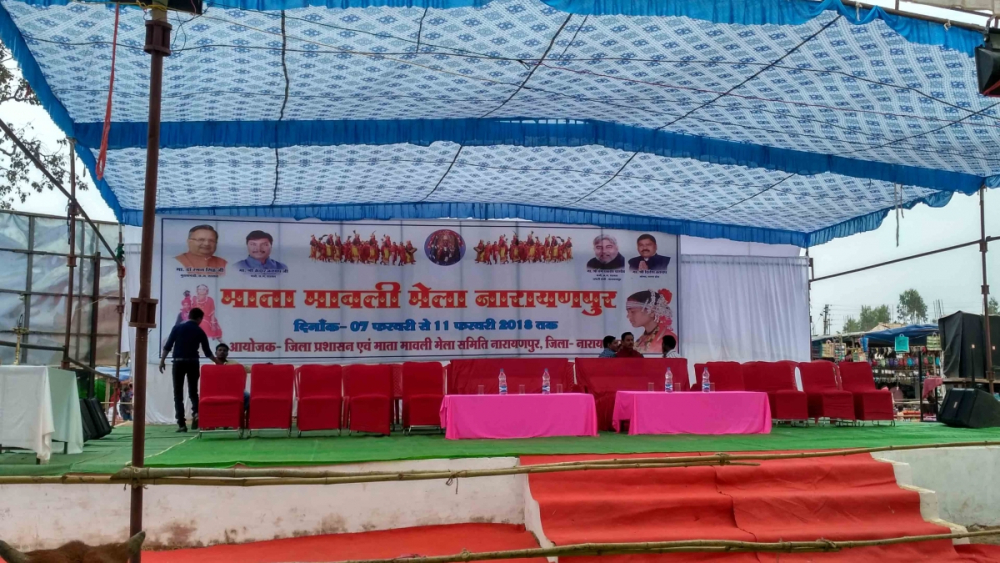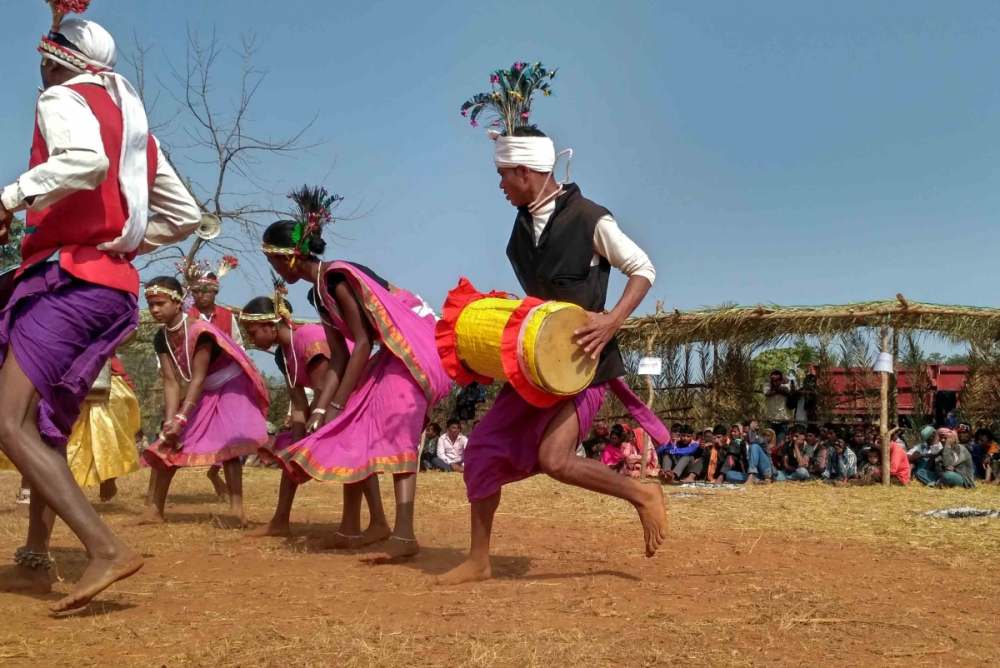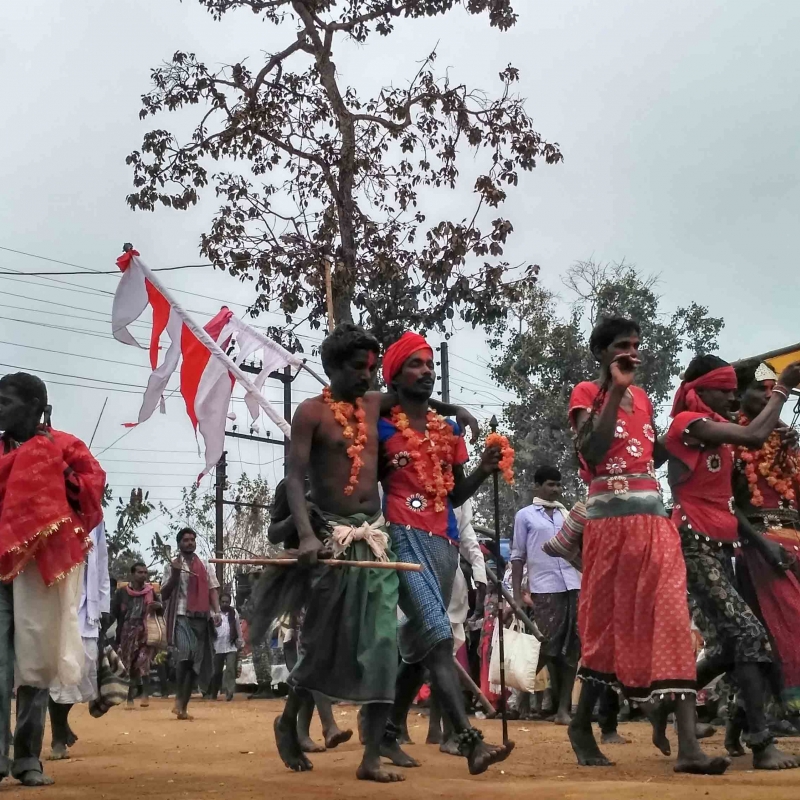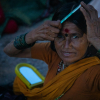Madai: Rituals in the bazaar
As the paddy crop ripens and the season of harvest starts, the air gets nippy in the southern hinterlands of Satpura. November slips away as the ripe golden crop sways in the cool breeze and women start reaping the harvest. Harvesting ends as December brings with it the winter winds. The Gond villages prepare for the Poush Kolang; hand in hand, the adivasis dance for hours, singing rela. After the full moon of Poush (the early winter month of the Saka calender), Gonds offer their first harvest to their ancestral gods. Following this, villages and towns across Gondwana (eastern Madhya Pradesh and Chhattisgarh) organize Madais or fairs. These fairs continue throughout winter and stretch up to the month of Chaitra as spring gives way to summer. This extended stretch of time across which the Madais are organized also gets punctuated by various festivals of both the Gonds and the Hindus which are celebrated in varying degrees by the people of Gondwana.
As I have observed, all across eastern MP (Madhya Pradesh) and Bastar, Madais are fairs where men, women, children and their ancestral gods come close to each other. They meet their distant relatives after the harvest, buy gifts for each other and buy things essential to everyday life. It is also a place where young men and women get to meet each other and also where marital alliances are finalized; for many, it is also the place where marriage gifts are bought. Groups of young men and women are believed to be possessed by their ancestors and ancestral gods in the course of the celebrations. Elders, who have been participating in Madais since their childhood, talk about them both as a ritual and also as a bazaar. Lakhan Singh Marhavi, a Gond siyan (elder), who lives in a village of the Dindori district of MP, speaks of Madais as rituals in the bazaar.
Amongst the ethnographers of the colonial era, W.V. Grigson (1938) gives us a brief yet vivid account of the Madai. He observes that the idea of the Madai takes the popular Gond rituals beyond the realm of community, and blends it with the rituals of other communities who co-exist with Gonds in the region. Most of the urban centres and market places were populated and controlled by Hindu rulers and the Gond custom of karsaar blended with the Hindu customs of parikrama and jatra that gave shape to the Madai.
The Mandai (Madai) is a Hinduization of the old pen karsita. Throughout northern Bastar, a Mandai jatra is held at all big centres culminating in the great Mandai in an open space, called the Kodo Bhata in Jagdalpur. This, the chief would attend in state, riding an elephant seven times round the fair, accompanied by the innumerable mediums (anga, dang, danda are wooden structures carried by men; it is believed that the spirits enter those who carry these structures) leaping and dancing, possessed by their gods (Grigson 1938:220).
The changing landscapes in the Madai of Narayanpur
Lakhan Mandavi lives in Markabera, 15 kilometers away from Narayanpur. He is one of the organizers of the Narayanpur Madai. He arranges for shelters, prepares the deo sthal and also mobilizes communities to cook so that travellers, dancers and those involved in the elaborate rituals can eat when the celebration is over. He spoke to me as I travelled back to his village when the first day of the Narayanpur Madai had got over.
He referred to the arrangements that he had been making for over a month. As a member of the Gondwana Samaj, he had also been responsible for clearing out grounds for car parking. ‘The Narayanpur Madai is so famous now that the state government or the police cannot manage the flow of cars and bikes. The samaj, therefore, also takes responsibility for managing parking space.’ They collect a nominal fee in exchange, which they use to cook for those who are involved in the rituals, or to build shelters for villagers who have arrived from far-off villages. As our conversation proceeded, he told me how things had changed in the Madai. During his childhood (about 20 years back), there would barely be any cars or motorbikes, people would walk down from far-off villages. Although people still walk down, a big number also arrive on motorbikes, and some people have also started coming in cars or hired vans. He added that the biggest attraction of the Narayanpur Madai was its ritual ceremony as ancestral gods from over six parganas converged in the mela (fair), Mawali devi being the principal deity. ‘Most of the gods comes to meet Mawali devi.
With a slight grin, he said that these days the gods barely mattered. People came for manoranjan; they paid for the various rides such as the merry go round, giant wheel, watched a show called 'Maut ka Kuan' or ate popcorns and ice creams and then returned home. He complained that the dances in the deo sthal were disappearing and the state government was organizing competitions only for group dances.
Instead of dancing for their ancestral gods and for their own satisfactions they waited to participate in competitions for prizes; instead of dancing for hours in the deosthal they only dance for a few minutes on the stage. The stage is barely the place to do such dances but these days it is just for entertainment of the state officials and for the crowd.
The Narayanpur Madai had a huge stage for 'tribal dance' competitions where district collectors, inspector generals and MLA s of the district, and also from neighbouring districts, came to watch the spectacle; the small Madai of Tarandul (a remote village in Bhanupratappur block of Kanker district) still holds long dance sessions around the deo sthal. There are no prizes on offer, but a lot of sulphi ( local alcoholic beverage) for all; after a tiring four-hour session of continuous dancing and singing, one needs to relax in the evening.

The stage in Narayanpur Madai

Dance during Madai Mela
The fairy lights and the merry-go-rounds: Fantasy and indulgence in madais
The Madais of the bigger towns of Bastar and Mandla are known for their glitz and glamour. One often finds people referring to the bigger Madais with some reverence. Larger stalls of food, elaborate arrangements for entertainment set them apart from the smaller Madais. Joy rides of various kinds, ranging from Maut ka Kuan (A stunt show where motor vehicles and cycles are driven inside a well- like structure made with wooden planks at high speeds. The circular motion allows the cars and the bikes to climb the walls of the well. The audience stands on the upper edge of the well to watch the stunts) to giant wheels add to the spectacle. Along with such joyrides one finds elaborate food parks with popcorns, cotton candies, chowmein, ice creams, flavoured sodas and many other kinds of fast food. One can easily mark the difference between the small town Madais and those in the bigger towns as one can barely notice the space for kukri bazaar or for dances which are performed around the deo sthal.
In central Chhattisgarh and northern Bastar, people often go for theatrical performances which are put up by nacha parties. Nacha parties of Dhamtari and Nagri are famous for their nightlong performances on popular issues, although in the towns of Mandla and Dindori districts of Madhya Pradesh, one can experience a completely different kind of entertainment.
In Mandla, one can observe that the dancing ends with the Madai rituals during the day and the evenings are generally more about attending magic shows (kala jadu) and dance shows that are organized inside huge canvas tents by groups of performers who come from all corners of the country. People buy tickets for these shows while treating themselves to sodas, ice creams and popcorn. The idea is to indulge in things which are otherwise prohibited. For the evening of the Madai, there are fewer societal restrictions which are imposed by the otherwise moral society. Although young men come with their male companions and women come with their female companions, glances are often exchanged as they move in and around the fair; some men also offer pan (betel leaves) to those whom they like, and if the lady accepts the pan it is considered that she has accepted his advances. The dance groups and the kala jadu performances are slightly more sexually provocative than the theatrical performances. Inside the dance group tents, young women dance to popular Chhattisgarhi and Bollywood songs at a safe distance from the cheering crowd; needless to say, the number of males far outnumber the number of females in the crowd. The performers generally wear glittery costumes and sway to popular numbers to keep the crowd of young men on their toes; whistling and clapping continue as long as the songs continue (generally for four to five minutes) after which other dancers start their performance accompanied by another song; after three to four songs, the show comes to an end. Many excited youth instantly buy another ticket and enjoy the show yet again.
The scene is a little different inside the kala jadu tent. Both males and females sit together to enjoy the magic show; a glittery costume-clad lady accompanies the magician who generally appears in black baggy clothes and performs various magic tricks, such as cutting up his female companion and putting her back in one piece or making birds vanish and bringing them back again out of the thin air. Following these, card games are played and the crowd is allowed to be a part of those games. At the end of the performance, they also promise solutions and resolutions for those who have failed in their romantic pursuits. The crowd is however requested to seek personal consultation for such services.
For the past few decades, the trend of arranging for such entertainment troops has picked up amongst Madai organizers. The Panchayat committees which organize the Madais invite performers from various corners of the country. Consequently, a large number of kala jadu performers have started migrating from Bengal as throughout Chhhattigarh and eastern MP, people from Bengal are frequently identified as 'black magicians'.
Apart from performers, traders from various parts also converge in the bigger Madais. Sindhis and Marwaris are seen running big shops in the Madais. The Sindhi trade everything from forest produce to daily need items such as soap, cooking oil, salt and sugar while Marwaris deal with metal ware and silver jewelleries. The local brahmins and Rathores from Rajasthan (they identify themselves as Rajputs) also control big businesses such as transportation, big sweet shops and mobile phone stalls. Amongst all of these, the mobile phone stalls attract most of the attention. One will find people of all age and gender crowding around the stalls either checking out new Chinese phones with louder speakers and bigger screens than the ones that they already have, or quickly downloading the latest videos and songs. Although cell phone connectivity remains limited, the smart phones have now become portable devices of entertainment for all. From Bollywood and Chhattisgarhi numbers to pornographic videos—all get downloaded and distributed through these mobile phone stalls.
The corporations, the state and the community: Neo liberal trends in Madais of Gondwana
In the recent past, the bigger traders have started sponsoring the infrastructural expenditure of the bigger Madais. They sponsor expenditures, such as the construction of the huge performance stage of the Narayanpur Madai and the construction of the various governmental stalls belonging to different departments. In exchange, the government allows the traders to set up huge stalls where they display every kind of industrial commodity ranging from tractors, motorbikes and agricultural implements to mobile phones and pharmaceuticals. The government departments also collaborate with the traders to promote industrial scale agriculture and live stock rearing practices. Many traders have also started commodifying certain forest products such as honey, coarse millets and herbs, and have also started promoting production and marketing of handicrafts such as bamboo jewellery, pen stands and window blinds for urban consumers who have started visiting Madais.
If one has observed Madais over the last few decades, one will be able to chart the slow transition of its appearance and character without much trouble. What was predominantly an event where gods and humans of the Gond samaj and also of the other communities met, bought and exchanged goods, has slowly morphed into a market through which large corporations and the state are trying to push their commercial and governance agendas. One can safely say that bigger Madais of Bastar, Northern Chhattisgarh (including the eastern Madhya Pradesh) have taken a neo-liberal turn. More and more people turn up today not to participate in the Madai or meet their relatives but rather as consumers to buy commodities and consume entertainment services which often help them to sublimate their fantasy. But it would be wrong to say that a 'need' based economy has ceased to exist in the Madai. Certain gotras amongst Gonds who do not have the knowledge of metal crafts also come to buy iron agricultural tools, some also come to buy earthen pots and cookware from the potters, some still exchange their forest produce for salt, sugar and oil; many still come to arrange fights for their cocks and win some more cocks in return; some still dance as they feel that it is through their bodies that their ancestors speak to their relatives. Such instances even in the bigger Madais turn them into unique spaces where the globalized world order coexists with the residual cultures of the adivasis and prevents the Madai from becoming a fair.
References
Grigson, W.V. 1938. 'The Annual Religious Ceremonies of the Bison-horn Marias’, in The Maria Gonds of Bastar, pp.208–21. London: Oxford University Press.













